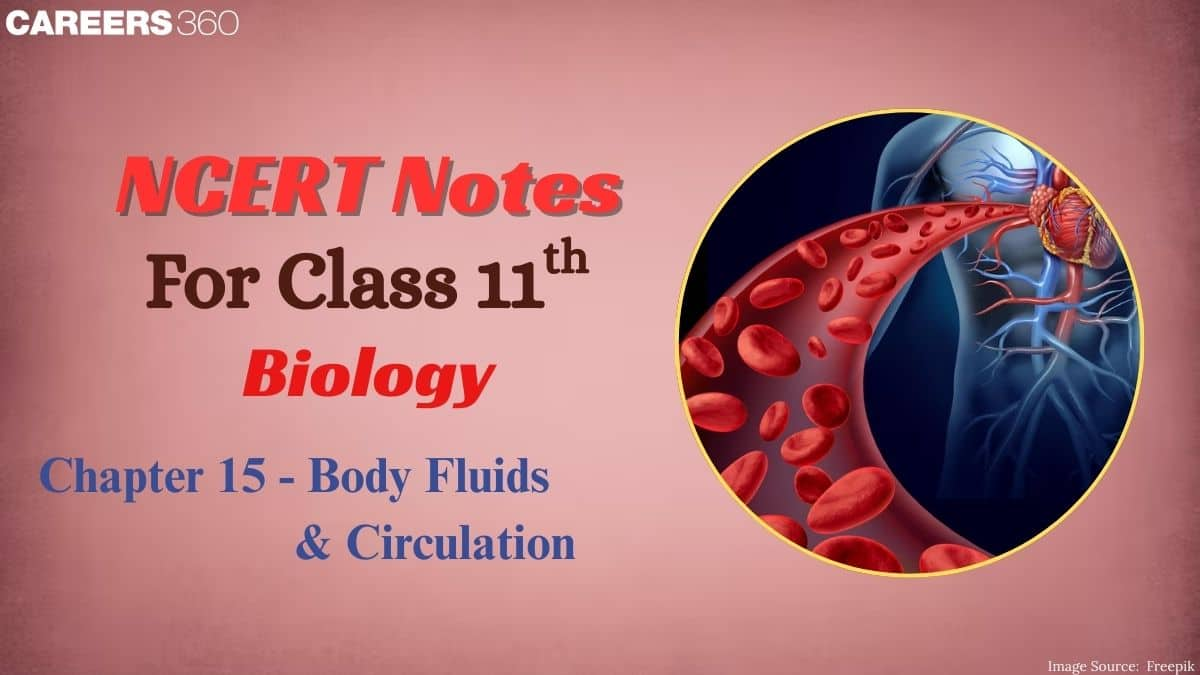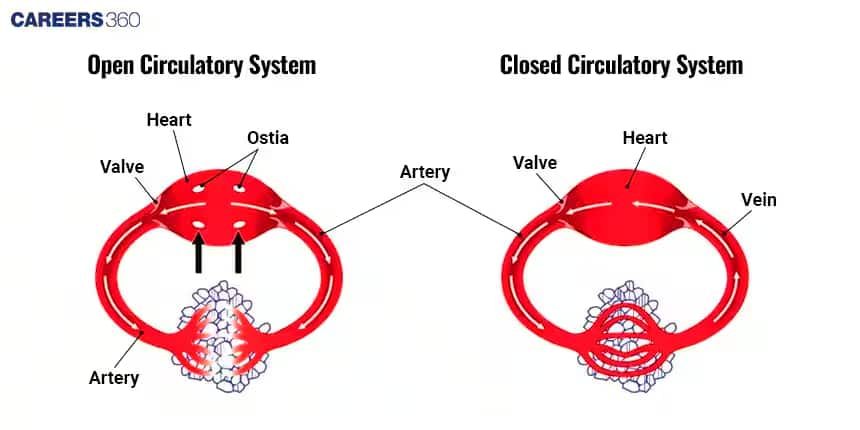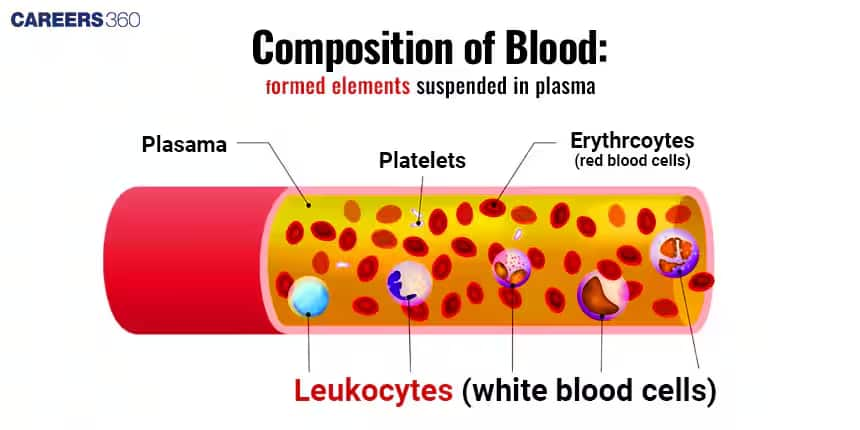NCERT Class 11 Biology Chapter 18 Notes Body Fluids And Circulation- Download PDF Notes
Have you ever thought about how oxygen and nutrients travel throughout the body? The NCERT Class 11 Biology Chapter 15 Notes Body Fluids And Circulation explain this simply and easily. These notes include clear points, labelled diagrams, and solved previous year questions, so that students can understand topics without confusion. Students will read about blood, lymph, the heart, blood vessels, and the double circulation system. The NCERT Notes also work well for students when they need a fast recap before board exams or NEET.
This Story also Contains
- NCERT Class 11 Biology Chapter 15 Body Fluids And Circulation Notes: Download PDF
- Class 11 Biology Chapter 15 Body Fluids And Circulation Notes
- Chapter 15 Body Fluids and Circulation: Previous Year Questions and Answers
- How to Use Body Fluids And Circulation Class 11 Notes Effectively?
- Advantages of Class 11 Biology Chapter 15 Body Fluids and Circulation Notes
- Chapter-Wise NCERT Class 11 Notes Biology

In the Body Fluids and Circulation Class 11 Notes, students will find organised explanations of the structure of the heart, the cardiac cycle, and how blood pressure is controlled. Diagrams are also included in the NCERT Class 11 Biology Chapter 15 Notes PDF, which improves the way of writing answers in exams. All points are set in order so that the study can be done smoothly. Using these NCERT Notes for Class 11, students can build confidence in subjects and connect the concepts with other chapters.
NCERT Class 11 Biology Chapter 15 Body Fluids And Circulation Notes: Download PDF
Having the notes in PDF format is beneficial because students can access them anytime without needing the internet. Students can download the NCERT Class 11 Biology Chapter 15 Notes PDF from the link given below. It helps to revise faster, stay organised, and keep all key points in one place. For clear and quick exam preparation, the NCERT Class 11 Biology Notes are a valuable resource.
Also Read:
Class 11 Biology Chapter 15 Body Fluids And Circulation Notes
The Body Fluids and Circulation chapter talks about how blood and other fluids deliver oxygen and nutrients, remove wastes, the heart’s structure, blood vessels, the cardiac cycle, and how the body defends itself. The Body Fluids and Circulation Class 11 Notes include diagrams and key terms, following the latest NCERT guidelines, making them great for quick revision.
Body Fluids and Their Composition
In living organisms, body fluids have an important role in the transportation of nutrients, gases, and waste products. Blood and lymph are the two principal body fluids in humans.
Blood: Structure and Functions
Blood is a specialized connective tissue that has critical functions, including the transport of oxygen, immunity, and homeostasis. It contains:
- Plasma: The liquid component of blood, which constitutes approximately 55% of its volume. Plasma consists of water (90-92%), proteins (albumin, globulin, fibrinogen), electrolytes, nutrients, hormones, and waste products. Plasma aids in transport and clotting.
- Red Blood Cells (RBCs): Also referred to as erythrocytes, they have haemoglobin, which is responsible for binding oxygen and transporting it to tissues. RBCs do not have a nucleus in mammals and live for approximately 120 days.
- White Blood Cells (WBCs): Also referred to as leukocytes, they are important for immunity. They are of five types – neutrophils, eosinophils, basophils, lymphocytes, and monocytes – each with a particular immune function.
- Platelets (Thrombocytes): These assist in blood clotting by releasing clotting factors that create a fibrin mesh, stopping excessive blood loss.
Lymph
Lymph is a colourless fluid that is obtained from blood plasma. Unlike blood, it does not contain RBCs and contains less protein. Its roles are as follows:
- Transport of vitamins and fatty acids from the intestine to the blood.
- Assisting in immune function by transporting lymphocytes.
- Removal of excess interstitial fluid to avoid tissue swelling (edema).
Formed Elements
Formed elements include erythrocytes (RBCs), leukocytes (WBCs), and platelets. They make up about 45% of the blood volume.
Erythrocytes (Red Blood Cells, RBCs)
- Most abundant blood cells: ~5–5.5 million per mm³ of blood in adults.
- Produced in red bone marrow.
- Biconcave, no nucleus in most mammals.
- Contains haemoglobin (12–16 g/100 ml), which is responsible for oxygen transport and red colour.
- Life span: ~120 days; destroyed in the spleen (“graveyard of RBCs”).
Leucocytes (White Blood Cells, WBCs)
- Colourless, nucleated, fewer in number: 6000–8000 per mm³ of blood.
- Short-lived cells.
The two categories of leucocytes are:
Granulocytes
- Neutrophils: most abundant WBCs (60–65%), phagocytic
- Basophils: rarest (0.5–1%), secrete histamine, serotonin, and heparin (inflammation)
- Eosinophils: 2–3%, resist infections and are linked to allergies
Agranulocytes
- Lymphocytes: 20–25%, B and T types, responsible for immune responses
- Monocytes: phagocytic, 6–8%
- Platelets (Thrombocytes)
- Fragments of megakaryocytes in bone marrow
- Count: 1,50,000–3,50,000 per mm3 of blood
- Helps in blood clotting by releasing substances involved in coagulation
- Low platelet count can cause clotting disorders and excessive bleeding
Blood Groups and Their Significance
Knowing a person’s blood group is important for safe blood transfusions, organ transplants, and even during pregnancy to avoid complications like hemolytic disease of the newborn. Blood groups are grouped based on the absence or presence of certain antigens on RBC surfaces. There are two major group systems:
ABO Blood Group System
Established by Karl Landsteiner, this is based on the presence of antigen A and antigen B on RBCs and plasma antibodies accordingly:
- Type A: Antigen A on RBCs, Anti-B antibodies in plasma.
- Type B: Antigen B on RBCs, Anti-A antibodies in plasma.
- Type AB: Both A and B antigens on RBCs, with neither antibody (universal recipient).
- Type O: No A or B antigens, both Anti-A and Anti-B antibodies (universal donor).
Rh Factor and Its Medical Significance
- The Rh factor is a second antigen (Rh antigen or D antigen) found in RBCs.
- People with Rh antigens are Rh-positive (Rh⁺), and those who lack them are Rh-negative (Rh⁻).
- An Rh⁻ mother who is pregnant with an Rh⁺ baby may develop hemolytic disease of the newborn (HDN), in which maternal antibodies destroy fetal RBCs.
Circulatory Pathways in Humans
Blood circulation may take various forms based on the complexity of an organism.
Open vs. Closed Circulatory System
- Open Circulatory System: Arthropods and molluscs. Blood (hemolymph) moves freely in body cavities without enclosed vessels.
- Closed Circulatory System: Annelids and vertebrates. Blood travels through a network of blood vessels, with an effective oxygen and nutrient supply.

Single vs. Double Circulation
- Single Circulation: Blood moves through the heart once per cycle (e.g., fishes).
- Double Circulation: Blood circulates through the heart twice in each cycle (e.g., humans, birds, mammals), making oxygenation more efficient.
Pulmonary and Systemic Circulation
- Pulmonary Circulation: Delivers deoxygenated blood from the heart to the lungs to be oxygenated.
- Systemic Circulation: Supplies oxygenated blood from the heart to body tissues and brings back deoxygenated blood.
Structure and Function of the Human Heart
The human heart is a four-chambered muscular organ in the thoracic cavity.
Anatomy of the Heart
- Right Atrium and Right Ventricle: Accept deoxygenated blood and send it to the lungs.
- Left Atrium and Left Ventricle: Accept oxygenated blood and send it to the body.
- Valves (Tricuspid, Bicuspid, Pulmonary, Aortic): Stop backflow and control blood movement.
Cardiac Cycle and Heartbeat Regulation
The cardiac cycle involves systole (contraction) and diastole (relaxation) for rhythmic blood flow. The normal heartbeat of a human is 72 beats per minute.
Function of the SA Node and the AV Node
- Sinoatrial (SA) Node: Pacemaker of the heart, creating electrical impulses.
- Atrioventricular (AV) Node: Impulse delay, facilitating coordinated contraction.
Blood Vessels and Their Functions
Three types of blood vessels transport blood:
Arteries: Carry oxygenated blood (except the pulmonary artery) under high pressure.
Veins: Carry deoxygenated blood (except pulmonary vein) with valves to prevent backflow.
Capillaries: Facilitate gas and nutrient exchange at the tissue level.
Mechanism of Blood Circulation
The process of blood circulation is described as:
Blood Pressure and Pulse Rate
- Blood Pressure (BP): The Pressure blood exerts against vessel walls. Normal BP is 120/80 mmHg.
- Pulse Rate: Heartbeat rate per minute, showing the heart's condition.
Regulation of Circulation by Hormones and the Nervous System
- The medulla oblongata regulates heart rate and BP.
- Hormones such as adrenaline elevate heart rate, while acetylcholine decreases it.
- The sequential event in the heart that is cyclically repeated is called the cardiac cycle.
Common Circulatory Disorders
Some common circulatory disorders included in the Body Fluids and Circulation chapter are given below:
1. High Blood Pressure (Hypertension)
- BP greater than 140/90 mmHg can lead to heart disease.
- Resulting from stress, obesity, and salt consumption in excess.
2. Atherosclerosis
- Atherosclerotic plaques of cholesterol contract the arteries and curtail the circulation of blood.
- Results in heart attacks and strokes.
3. Stroke
- Damaged or ruptured cerebral vessels produce paralysis or loss of speech.
4. Heart Attack (Myocardial Infarction)
- Closure in the coronary vessels halts the heart muscle's oxygen supply, which results in injury to the muscle tissues.
Prevention and Lifestyle Changes
- Optimal diet (low cholesterol, low salt).
- Regular exercise to maintain BP and circulation.
- Stress management and avoiding smoking/alcohol.
Also Read
Chapter 15 Body Fluids and Circulation: Previous Year Questions and Answers
Some of the questions that have come in past years from the chapter are given below. To solve these questions easily, students can use the NCERT Class 11 Biology Chapter 15 Notes Body Fluids and Circulation.
Question 1. What would be the cardiac output of a person having 72 heartbeats per minute and a stroke volume of 50 mL?
Option 1. 360 mL
Option 2. 3600 mL
Option 3. 7200 mL
Option 4. 5000 mL
Answer :
The volume of blood the heart pumps in a minute is known as cardiac output, and it is measured in litres per minute. It makes sense that cardiac output is equal to the product of heart rate (the number of beats per minute) and stroke volume.
Cardiac output = Stroke volume x heart rate
=50 x 72
=3600mL
Hence, the correct answer is option (2) 3600 ml
Question 2. Which of the following statements is incorrect?
Option 1. A person of the ‘O blood group has anti-'A’ and anti-'B’ antibodies in his blood plasma.
Option 2. A person of ‘B’ blood group can’t donate blood to a person of ‘A’ blood group.
Option 3. Blood group is designated on the basis of the presence of antibodies in the blood plasma.
Option 4. A person of AB blood group is a universal recipient.
Answer :
Blood group is based on the presence or absence of antigens A and B on RBCs and the presence or absence of two natural antibodies present in plasma.
Hence, the correct answer is option (3). Blood group is designated on the basis of the presence of antibodies in the blood Plasma.
Question 3. Which of the following correctly explains a phase/ event in the cardiac cycle in a standard electrocardiogram?
Option 1. The QRS complex indicates atrial contraction.
Option 2. The QRS complex indicates ventricular contraction.
Option 3. The time between S and T represents atrial systole.
Option 4. P-wave indicates the beginning of ventricular contraction.
Answer :
Ventricular contraction is caused by the depolarization of the ventricles, which is represented by the QRS complex in a normal electrocardiogram (ECG/EKG). The electrical signal that triggers the ventricular muscles' mechanical contraction is known as depolarisation.
Because it causes blood to be pumped from the ventricles into the aorta and pulmonary artery, this stage of the cardiac cycle is crucial.
Hence, the correct answer is option (2). The QRS complex indicates ventricular contraction.
Question 4. Which blood vessel carries oxygenated blood from the lungs to the heart?
Option 1. Pulmonary artery
Option 2. Pulmonary vein
Option 3. Coronary artery
Option 4. Inferior vena cava
Answer:
Unlike most veins, the pulmonary vein carries oxygenated blood from the lungs to the left atrium of the heart. The pulmonary artery, in contrast, carries deoxygenated blood from the heart to the lungs.
Hence, the correct answer is option (2) Pulmonary vein.
Question 5. The ‘lub’ sound of the heart is produced by
Option 1. Closure of semilunar valves
Option 2. Opening of AV valves
Option 3. Closure of AV valves
Option 4. Opening of semilunar valves
Answer:
The first heart sound (‘lub’) is produced when the atrioventricular (AV) valves—the tricuspid and bicuspid valves—close at the beginning of ventricular systole. This prevents the backflow of blood into the atria.
Hence, the correct answer is option (3) Closure of AV valves.
Also Read:
How to Use Body Fluids And Circulation Class 11 Notes Effectively?
Body fluids and circulation are important for maintaining life, as they transport nutrients, gases, and wastes throughout the body.
Study the structure and function of the heart, blood vessels, and lymphatic system to understand how blood and other body fluids circulate.
Use Class 11 Biology Chapter 15 Body Fluids and Circulation Notes PDF to revise the components of blood, including plasma, red blood cells, white blood cells, and platelets.
Refer to the notes to understand the cardiac cycle, heart sounds, and how the heart maintains rhythmic contractions for effective circulation.
Go through the Class 11 Biology Chapter 15 Body Fluids and Circulation Notes to learn about blood pressure and the factors affecting circulatory efficiency.
Revise disorders related to the circulatory system, such as hypertension, atherosclerosis, and anemia.
Advantages of Class 11 Biology Chapter 15 Body Fluids and Circulation Notes
Going through the well-organised notes makes students understand the composition of blood, its circulation, and the functioning of the human heart. The notes offer several advantages, some of which are listed below:
- Class 11 Biology Chapter 15 Body Fluids and Circulation Notes PDF provides clear summaries of blood components, plasma, and other elements.
- The structure and working of the human heart are explained in the notes, along with the well-labeled diagram.
- By studying through the notes, students can understand concepts like double circulation, cardiac cycle, and ECG easily.
- Consistent practice and regular revision increase conceptual clarity and improve performance in both board exams and competitive exams like NEET.
Chapter-Wise NCERT Class 11 Notes Biology
Here, students can find the notes of all chapters that explain all topics clearly and help in quick revision for exams.
Frequently Asked Questions (FAQs)
Blood is composed of plasma (liquid component), red blood cells (RBCs), white blood cells (WBCs), and platelets. Plasma carries nutrients, RBCs transport oxygen, WBCs combat infection, and platelets assist in blood clotting.
The heart circulates oxygenated blood by arteries to the tissues of the body and collects deoxygenated blood via veins. The pulmonary circulation transmits gases within the lungs, whereas systemic circulation delivers oxygen to tissues.
- Open Circulatory System: Blood is freely flowing in body cavities without having enclosed vessels (e.g., arthropods).
- Closed Circulatory System: Blood is kept within vessels for effective transport (e.g., humans, vertebrates).
Oxygen gets attached to hemoglobin in RBCs, making oxyhemoglobin. It is carried to tissues by arteries, and it is released for cellular respiration, whereas carbon dioxide is transported back to the lungs for expulsion.
The heart sends blood around the body through periodic contractions. It delivers oxygenated blood to tissues and carbon dioxide-laden blood to the lungs to be cleaned through pulmonary circulation. For a more detailed explanation, students can refer to the NCERT Class 11 Biology Chapter 15 Notes Body Fluids And Circulation.
- Arteries: Transmit oxygenated blood from the heart at high pressure.
- Veins: Pump deoxygenated blood back to the heart with the assistance of valves.
- Capillaries: Allow gas, nutrient, and waste exchange at the tissue level.
Platelets release clotting factors that create a fibrin mesh at sites of injury, avoiding undue bleeding. They are essential to the coagulation cascade, arresting blood loss and assisting wound closure.
Lymphatic system empties excess tissue fluid (lymph), conveys immune cells, and facilitates fat absorption in the intestine. It is involved in infection resistance by transporting lymphocytes.
Courses After 12th
Applications for Admissions are open.
As per latest syllabus. Physics formulas, equations, & laws of class 11 & 12th chapters
JEE Main Important Chemistry formulas
Get nowAs per latest syllabus. Chemistry formulas, equations, & laws of class 11 & 12th chapters
JEE Main high scoring chapters and topics
Get nowAs per latest 2024 syllabus. Study 40% syllabus and score upto 100% marks in JEE
JEE Main Important Mathematics Formulas
Get nowAs per latest syllabus. Maths formulas, equations, & theorems of class 11 & 12th chapters

